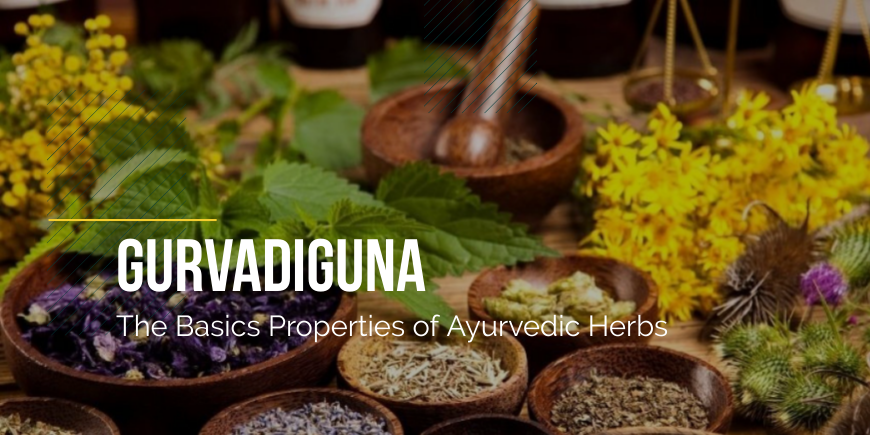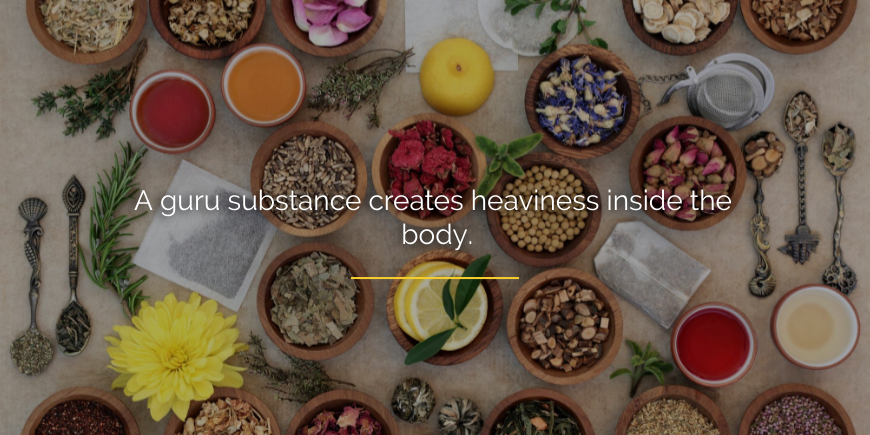
Introduction
Modern medicine has a quantifiable definition for the properties of herbs. Herbs may have different properties like anti-oxidants, anti-inflammatory, anti-aging, etc. However, still scientists are not able to understand multiple metabolic pathways. These herbs may produce these effects in a slightly different manner.
Properties like anti-oxidation, anti-inflammatory action are not stand-alone effects. They may be the result of a complex and multi-faceted metabolic action.
These properties are very basic, so a combination of these properties covers a wider variety of metabolic effects.
These basic Ayurvedic properties are called gurvadiguna. They are twenty in number, with 10 pairs of equal and opposite effects. The first guna is Gurutva or heaviness. Hence this group of Gunas starting with Gurutvais called gurvadiguna. These Gunas cover all the possible metabolic actions of a substance on the human body.
In future blogs, we will use these properties in all Ayurvedic concepts like properties of dosha, dhatu, Ayurvedic pathogenesis, and mode of action in Ayurvedic herbs/medicines.
Summary
Ayurveda has a wide range of specific physical properties that define the action and metabolic effect of a substance on the body – heaviness, lightness, etc. These 20 properties are instrumental in understanding Ayurvedic herbalism.
Gunas (Metabolic Properties)
1 | Guru | Heavy | Laghu | Light |
2 | Sheet | Cold | Ushna | Hot |
3 | Snigdha | Moist/Unctuous | Ruksha | Dry |
4 | Mand | Dull | Tikshna | Sharp |
5 | Sthir | Stable | Sar | Mobile |
6 | Mrudu | Soft | Kathin | Hard |
7 | Vishad | Clear | Pichchil | Slimy |
8 | Shlakshn | Smooth | Khar | Rough |
9 | Sukshm | Fine/Subtle | Sthul | Bulky |
10 | Sandra | Solid | Drav | Fluid |
In addition to herbs, these properties apply to foods, lifestyles, climatic conditions, and any other factor affecting our metabolism.
Metabolic Significance of Gunas
Guru (Heavy)
This property emerges from the earth element. Earth or any planet forms when particles condense around a single point of gravitational attraction. Similar development happens in the case of Gurutva or heaviness. This is the reason gravitational force has a Hindi synonym called – Gurutvakarshan(attraction of Gurutva/property of heaviness).
A guru substance creates heaviness inside the body. For example, butter or oil naturally creates heaviness inside the body. However, a substance doesn’t need to be oily to create heaviness. Essential oils do not create any heaviness, instead, they help relieve heaviness. On the other hand, cheese or mushrooms are non-oily edibles, yet they are heavy for the body.
There is another metabolic aspect of heaviness. A heavy substance is normally difficult to digest and absorb. Therefore, heaviness comes as a tendency to become compact. Something compact is difficult to break down. Yet, it again creates compactness after being broken down. So, these Gunas are basically the metabolic tendencies of a substance.
For example, animal fat melts when heated, but it may solidify again. So, it tends to solidify or become dense. Still, heaviness is not dependent on solidity. It is a distinct property. It may or may not create solidity. For example, the oil is heavy but not solid. If you eat a lot of oil, you may feel heavy.
In terms of lifestyle, sleep creates heaviness in the body. You may feel heavy on a cloudy day. Therefore, anything that affects our mind or body can be a guru.

Laghu (Light)
Laghuvtaor lightness is the integral property of the space element. However, it also exists in the air and fire elements.
Laghutva or lightness is the opposite property to Gurutva (heaviness). A laghu substance tends to bring lightness to the body. Besides, a laghu substance is easy to digest.
So, a laghu substance easily assimilates into the body and produces lightness. For example, Indian clarified butter or ghee is laghu. Despite being oily, the body can quickly digest and assimilate ghee. On the other hand, yogurt (a fermented product) is heavy, as it tends to stay compact.
Another interesting example is alcohol. Alcohol is light and spread quickly in the body.
Summary
Gurutva (Heaviness) and laghutva(lightness) are properties that balance each other. Heaviness provides the basis for growth and development, but its excess may lead to obesity, Kapha disorders, etc. Lightness helps the body through proper digestion and assimilation. However, excess lightness may cause light-headedness, a thin and weak body, malnutrition, etc.
Sheet (Cold)
This is the next set of properties (cold-hot), where coolness is more important than heat. Coolness sustains and elongates life. We can preserve sperms and other living tissues through cryostasis (preservation through the ice).
We all know about exothermic and endothermic reactions. These are two types of reactions, divided based on energy transactions. For explaining sheetatva (coolness), let us focus on the endothermic reactions.
Endothermic reactions are the ones that absorb more energy than they produce. Therefore, they have an overall cooling effect on the environment. For example, melting ice absorbs energy from the surrounding. Therefore, as the snow melts the environment becomes cooler.
Almost all cooking processes are examples of endothermic reactions because the food absorbs heat. This heat breaks the intracellular bonds and makes the food softer and easier to digest.
Similarly, there is metabolic cooking that goes inside our digestive system. Our alimentary canal cooks the ingested food with digestive juices to extract nutrients from the food. When the food interacts with the digestive juices, it may absorb the heat and produce a cooling effect in the body. Such substances are called Sheet or cooling for the body.
Some of the cooling Ayurvedic herbs are sandalwood, green cardamom, fennel, licorice, etc.
Ushna (Hot)
Hot or warmth-producing substances produce exactly the other way. They produce excess energy during the digestion process. The commonest example is alcohol. It produces an instant warming effect in the body. Therefore, alcohol is a necessity in many regions with frigid climates.
Some common hot herbs are clove, cinnamon, black cardamom, black pepper, etc.
Summary
Sheet (cold) and ushna (hot) are two balancing properties. Coolness prevents inflammatory damage whereas heat stimulates and preserves the normal metabolism in the body.
Snigdha (Moist/Unctuous)
According to famous AyurvedacharyaHemadri, a substance that brings moisture, softness, and unctuousness is called Snigdha. Ghee or Indian clarified butter is an ideal example of a Snigdha substance.
A Snigdha substance doesn’t need to be heavy, liquid, soft, slow-acting, or slimy. These properties are closely related and form a very good combination. However, a Snigdha substance can be sharp. For example, castor oil is Snigdha, but it has a radically sharp action on the intestines.
Some of the everyday examples of Snigdha/unctuous substances are onion, garlic, clove, star anise, etc. The famous Ashwagandha is also unctuous.
This property is important as moisture is the primary nutritional carrier in the body. All the body cells bathe in the unctuous tissue fluid. Moisture prevents dryness and preserves the body’s homeostasis. All enzymes, hormones, and other secretions have moisture as their base.
However, this moisture is different from liquidity. Normally, liquids are full of moisture. For example, water, milk, etc. all have moisture to different levels, but petrol is an exception.
Ruksha (Dry)
Ruksha is the opposite balancing factor for Snigdha/unctuous. The word ruksha means dry and this property is also important as too much moisture may hinder the normal metabolism. MasterHemadri says that dryness is the power to extract moisture from a substance. Dryness may result in other properties like hardness, solidity, etc.
In the body, dryness is closely associated with deterioration. For example, dryness in the nerve cells (axons) leads to deterioration in the protective nervous sheath. As the natural nervous insulation is gone, the nerves may get severely damaged.
Dryness also leads to shriveling up of cells. For example, in the outer layer of skin, the epidermis forms as a result of dead, dry skin cells. If these cells were moist and living, they could attract more pathogens, and be more vulnerable to humidity, and external temperature fluctuations.
Summary
Snigdha (moist) and ruksha (dry) form a mutually balancing pair. Moisture is the very foundation for all metabolic functions. All hormones, enzymes, and body cells express life in presence of nourishing moisture. Dryness balances the excess moisture. For example, dry and dead skin cells protect the inner moist layers of the body.
Take Away
Gurvadiguna has 20 contrasting properties that balance the body. These properties are deeply connected with each other. For example, heaviness appears integral to solidity or moisture. But each property exists independent of others. These properties exist everywhere, in the human body, animals, plants, and even non-living. They are the connecting points for all entities in the universe.
In the next blog, let us take up the next properties of substances. As you read about Ayurvedic herbs in the coming blogs, I hope this information helps you to connect the dots.
Are you fascinated by the ancient healing practices of Ayurveda? Our Ayurveda Certification Course is designed to immerse you in this profound tradition and empower you with the knowledge and skills to promote wellness. Enroll now and embark on a journey of self-discovery and healing.
Responses